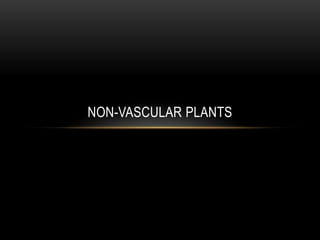Non vascular plants
•Descargar como PPTX, PDF•
3 recomendaciones•4,462 vistas
Nonvascular plants are the simplest land plants that lack internal water transport systems. They first evolved around 460 million years ago from green algae. They reproduce both sexually, with gametes developing in protective structures, and asexually through regeneration. Nonvascular plants are typically found in damp, shady areas as they cannot survive drying out and lack means to transport water over long distances. There are three divisions of nonvascular plants that share some characteristics but are distinct in other ways.
Denunciar
Compartir
Denunciar
Compartir

Recomendados
Más contenido relacionado
La actualidad más candente
La actualidad más candente (20)
INTRODUCTION OF LEAVES AND MODIFICATIONS OF LEAVES 

INTRODUCTION OF LEAVES AND MODIFICATIONS OF LEAVES
Algae. Classification of Algae. Chlorophyceae, Rhodophyceae, Pheophyceae. eco...

Algae. Classification of Algae. Chlorophyceae, Rhodophyceae, Pheophyceae. eco...
Angiosperms (flowering plants) PowerPoint Presentation

Angiosperms (flowering plants) PowerPoint Presentation
Similar a Non vascular plants
Similar a Non vascular plants (20)
Similarities and dissimilarities of algae and plants

Similarities and dissimilarities of algae and plants
Evolution of plants through different geological time scale

Evolution of plants through different geological time scale
Último
Último (20)
08448380779 Call Girls In Friends Colony Women Seeking Men

08448380779 Call Girls In Friends Colony Women Seeking Men
How to Troubleshoot Apps for the Modern Connected Worker

How to Troubleshoot Apps for the Modern Connected Worker
Strategize a Smooth Tenant-to-tenant Migration and Copilot Takeoff

Strategize a Smooth Tenant-to-tenant Migration and Copilot Takeoff
Automating Google Workspace (GWS) & more with Apps Script

Automating Google Workspace (GWS) & more with Apps Script
Bajaj Allianz Life Insurance Company - Insurer Innovation Award 2024

Bajaj Allianz Life Insurance Company - Insurer Innovation Award 2024
08448380779 Call Girls In Civil Lines Women Seeking Men

08448380779 Call Girls In Civil Lines Women Seeking Men
Powerful Google developer tools for immediate impact! (2023-24 C)

Powerful Google developer tools for immediate impact! (2023-24 C)
Boost PC performance: How more available memory can improve productivity

Boost PC performance: How more available memory can improve productivity
How to Troubleshoot Apps for the Modern Connected Worker

How to Troubleshoot Apps for the Modern Connected Worker
[2024]Digital Global Overview Report 2024 Meltwater.pdf![[2024]Digital Global Overview Report 2024 Meltwater.pdf](data:image/gif;base64,R0lGODlhAQABAIAAAAAAAP///yH5BAEAAAAALAAAAAABAAEAAAIBRAA7)
![[2024]Digital Global Overview Report 2024 Meltwater.pdf](data:image/gif;base64,R0lGODlhAQABAIAAAAAAAP///yH5BAEAAAAALAAAAAABAAEAAAIBRAA7)
[2024]Digital Global Overview Report 2024 Meltwater.pdf
Mastering MySQL Database Architecture: Deep Dive into MySQL Shell and MySQL R...

Mastering MySQL Database Architecture: Deep Dive into MySQL Shell and MySQL R...
Strategies for Landing an Oracle DBA Job as a Fresher

Strategies for Landing an Oracle DBA Job as a Fresher
Non vascular plants
- 2. • Nonvascular plants are the simplest of all land dwelling plants. Like their closest ancestors, the green algae, they lack an internal means for water transportation. They also do not produce seeds or flowers. They generally only reach a height of one to two centimeters, because they lack the woody tissue necessary for support on land.
- 3. EVOLUTIONARY HISTORY • Scientists possess fossil records that lead them to believe that plants evolved during four distinct periods. Nonvascular plants arose first, during the late Ordovician period of the Paleozoic Era, approximately 460 million years ago. Their closest non plant ancestor is a type of green algae called charophytes. • Scientists also believe that living in shallow water was a preadaptation to living on land. Natural selection probably favored algae (living on the fringes of bodies of water) that could survive through periods when they were not submerged. Waxy cuticles and jacketed organs, both characteristics of nonvascular plants, are possible adaptations that the algae developed to survive in these conditions.
- 4. REPRODUCTION • Nonvascular plants can reproduce both sexually and asexually. Asexual reproduction is the less common method. It basically consists of the regeneration of plant material, leaves or other parts, that fall to the ground and generate secondary plants which bear new buds. • Most nonvascular plants, though, reproduce sexually. Their gametes develop within structures called gametangia, which are organs that have protective jackets of sterile cells that prevent the gametes from drying out during development.
- 5. HABITATS • Nonvascular plants are almost always found in damp, shady places. They have little or no resistance to drying, and because they lack vascular tissue they cannot carry water from the ground to the aerial parts of the plant. Like sponges, they must imbibe the water lying on their surfaces and distribute it by the relatively slow means of diffusion, capillary action, and cytoplasmic streaming. Therefore, they cannot survive for very long in areas that are not constantly moist. Some can survive in alternative habitats such as sand dunes, but the majority thrive in dark, dank places. Because of their limited range of terrestrial habitats, nonvascular plants have never dominated much of the earth's landscape.
- 6. ENERGY ACQUISITION • Like most plants, nonvascular plants acquire energy through photosynthesis. During this process, the plant converts light energy into chemical energy, then proceeds to store it in the form of glucose or other organic compounds.
- 7. DIVISIONS • There are three divisions of nonvascular plants: Bryophyta, Hepatophyta, and Anthocerophyta. Until recently, scientists grouped all three together as one division, Bryophyta, but the current view is that they are probably not related. They do share some key characteristics, such as the presence of a waxy cuticle and gametangia, but they all have distinct characteristics that warrant separate divisions.
- 8. PHOTOS